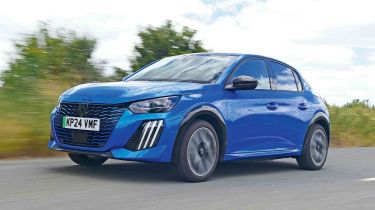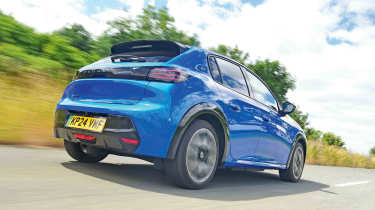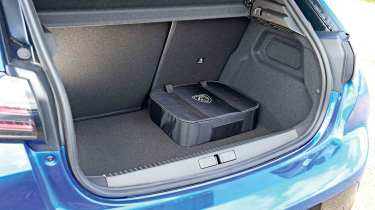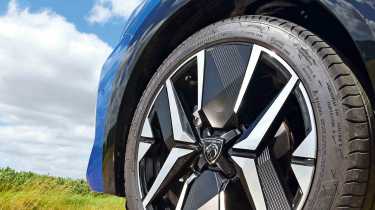Peugeot E-208 review
This stylish electric supermini has an upmarket cabin, but its high price dampens the appeal

Is the Peugeot E-208 a good car?
Cosmetic upgrades and a new 51kWh battery have given the Peugeot E-208 fresh appeal, but the small EV market has moved faster than this car’s development. It’s sound enough to drive, has a funky (if cramped) cabin, and the extra range will be handy for anyone who regularly drives out of town. But it’s tough to overlook pricing that seems to start where several capable rivals top out. Finance offers with chunky deposit contributions may be required here.
| Key specs | |
| Fuel type | Electric |
| Body style | Five-door supermini |
| Powertrain | 50kWh battery, 1x e-motor front-wheel drive 51kWh battery, 1 x e-motor front-wheel drive |
| Safety | Four-star Euro NCAP (2019) |
| Warranty | 3yrs/60,000 miles (up to 8yrs/100,000 with Allure Care) |
How much does the Peugeot E-208 cost?
Prices for the electric Peugeot E-208 start from around £28,000 for the Active model, rising to £30,000 for the Allure trim. The E-208 GT costs £32,000 when paired with a 50kWh battery or £33,000 for the 51kWh battery.
Unlike the regular Peugeot 208 supermini, which has petrol or hybrid power, the E-208 is all-electric. Launched in 2019 as the e-208, the electric supermini was facelifted in 2023, becoming the E-208, but retaining its status as Peugeot’s smallest electric car.
Its most obvious rival is the closely related Vauxhall Corsa Electric, but other small electric cars include the MINI Cooper, BYD Dolphin and MG4, along with used examples of the Honda e and Renault Zoe. Despite the competition, the E-208 is one of the best-selling electric cars in Europe.
Used - available now
There are three trims to choose from: Active, Allure and GT. Both the Active and Allure models are equipped with a 50kWh battery, while the high-spec GT model offers a choice of 50kWh or 51kWh batteries, the latter being introduced late in 2022.
All versions have a 10-inch touchscreen infotainment system, wireless connectivity for Apple CarPlay and Android Auto, LED headlights, LED rear lights, automatic lights and wipers, climate control and rear parking sensors, but you’ll need to upgrade to Allure or GT for the likes of alloy wheels, HD touchscreen, 10-inch digital instrument panel, front parking sensors and rear privacy windows. The GT model feels positively premium, thanks to 17-inch diamond-cut alloys, keyless entry and start, HD colour reversing camera, ambient lighting, sports seats, perforated leather steering wheel and an array of cosmetic upgrades.
Electric motor, performance & drive
Even before the introduction of the more powerful version, the E-208 was a well-sorted supermini. There’s decent compliance from the suspension around town, and instant punch to nip into gaps in the traffic.
On faster roads, the steering weights up a little inconsistently, and there’s a fair bit of body lean and head toss, but in general, the E-208 remains safe and predictable in bends. We wouldn’t say there’s much fun to be had here, though; this is not a car that really appreciates being chucked around. It does, however, have decent cruising comfort and a refined electric powertrain, so you end up with a car that’s well suited to urban use along with the odd longer motorway journey.
| Model | Power | 0-62mph | Top speed |
| E-208 GT 51kWh | 134bhp | 8.2 seconds | 93mph |
| E-208 Active 50kWh | 154bhp | 8.1 seconds | 93mph |
| E-208 Allure 50kWh | 134bhp | 8.1 seconds | 93mph |
In a bid to improve efficiency further, the amount of power the electric motor puts out depends upon which drive mode you’re using. The 51kWh version has enough shove in Normal mode for most situations, although stamping on the throttle will activate a ‘kickdown’ that overrides the settings and brings in the full 154bhp and 260Nm of torque. You pay a high price for choosing Eco mode, mind you; it detunes the motor down to 80bhp, and even with 180Nm of torque, you can feel this shortfall.
In truth, there’s very little difference between the 50kWh and 51kWh versions – the latter is actually slower to 62mph – so it all comes down to whether you need the additional range or the luxuries of the GT model.
Range, charging & running costs
The Peugeot E-208 has been available from launch with a 50kWh battery that can deliver a driving range of 225 miles on a combined cycle. In 2022, this was joined by a larger 51kWh battery that boosts the range to 248 miles between charging. In both cases, 200 miles should be achievable in the real world.
There’s 100kW DC charging as standard, so en-route recharges of 10 to 80 per cent should take around 30 minutes. A 50kW charging point should complete the same charge in 40 minutes, while a 7kW wallbox can fully charge an E-208 in seven-and-a-half hours. The E-208 is supplied with a Model 3 Type 2 cable for wallbox charging, but you’ll pay extra for the cable required for charging via a three-pin domestic plug socket. An 11kW three-phase on-board charger is also available as an option on all models, although this might not be worth having if you don’t have a three-phase electricity supply at home.
| Model | Battery size | Range | Insurance group |
| E-208 Active | 50kWh | 225 miles | 26E |
| E-208 GT | 51kWh | 248 miles | 28E |
| E-208 Allure | 50kWh | 225 miles | 27E |
Vehicle excise duty (VED) road tax will be free until the rules change in 2025, while favourable Benefit-in-Kind (BiK) rates make the E-208 an attractive proposition for company car drivers. It’ll be more expensive to insure than regular versions of the Peugeot 208, with group ratings of 26 to 28 (out of 50).
Residual values aren’t particularly stellar for the E-208, with the range retaining only around 36 per cent of its original value after three years or 36,000 miles. By way of comparison, the BYD Dolphin is predicted to maintain between 55 to 58 per cent of its value over the same period.
Design, interior & technology
Thanks to prices around the £30,000 mark, the Peugeot E-208 has to deliver a premium and practical experience to justify its numbers. Hence the 2023 facelift, which is designed to pile on features and keep it fresh.
The most obvious external difference is at the front, where the E-208 has been brought sharply into line with the fresher Peugeot 308 and Peugeot 408 models. The ‘claw’ daytime-running-light motif remains, but it’s been pushed towards the edges of the car’s nose, making it appear wider. There’s a redesigned bumper too, plus Peugeot’s updated logo and some flashes of body colour in the (flush) grille. These are worthy upgrades to our eyes, giving the car a slightly more aggressive appearance.
The tail lights have been refreshed too, switching from a vertical design to a horizontal one, and there are new designs of 16 and 17-inch alloy wheels, plus a couple of fresh paint colours.
The materials chosen for the cabin are a prime example of the difference between perceived quality and structural quality. They generally looked smart enough to us in our GT example, but the carbon-fibre weave-effect door panels and swathes of piano-black plastic don’t feel premium to the touch. There was a considerable disparity between the dashboard tolerances on either side of our car’s cabin, too – surprising on a car that’s been in production for several years.
Despite all of this, it’s still a slightly plusher environment in an E-208 than you’ll find in Vauxhall Corsa, and the materials are probably better resolved than they are in the likes of the BYD Dolphin or the MG4.
Sat-nav, stereo and infotainment
Inside, the old seven-inch infotainment system has been replaced on most versions by a 10-inch layout, although the resolution is crisper on the higher-end trim levels, Allure and GT. These versions also get a 10-inch digital instrument cluster, while the range-topping GT overlays projection-based 3D graphics onto the display.
The infotainment system is packed with features, but the menu system can be confusing at times and it’s less intuitive than the units you’ll find in an equivalent electric Hyundai or Kia.
Wireless Apple CarPlay and Android Auto connectivity is standard across the range, as is voice control and DAB radio. The GT model is also equipped with a wireless charger for charging your smartphone on the move.
Boot space, comfort & practicality
| Dimensions | |
| Length | 4,055mm |
| Width | 1,765mm (1,960mm including door mirrors) |
| Height | 1,430mm |
| Number of seats | 5 |
| Boot space | 309 litres (1,118 litres with the rear seats folded flat) |
Climb aboard the E-208, and you’re instantly reminded that this is one of the more compact superminis devoted to stylish touches more than outright practicality. The header rail feels low as you slide into either of the front seats, and things are even more compromised in the back, where headroom, legroom and kneeroom are all tight for anyone over six feet tall. The boot is a respectable 309 litres, but this is achieved through a fairly high load lip, and there’s no space beneath the floor, so you’ll have to throw your shopping on top of the charging cables.
Peugeot’s i-Cockpit layout, with a low-mounted small steering wheel that you look over the top of to see the instruments, is still a feature that won’t be to everyone’s liking. With our ample frame, we felt like we were wearing the car instead of sitting in it, and had to pull the wheel out too far for our liking, just for it to clear our knees.
Safety & reliability
| Key standard safety features | Euro NCAP safety ratings |
|
|
The Peugeot 208 (upon which the electric E-208 is based) finished an impressive sixth out of 50 models in our latest 2024 Driver Power customer satisfaction survey, with owners praising its exterior styling, excellent ride and handling, front-seat comfort, and performance. The feedback was less positive about the infotainment system and rear legroom, but not enough to prevent the 208 from securing a top ten finish.
To prove it was no fluke, the Peugeot brand finished sixth out of 32 brands in the best car manufacturer rankings, beating many premium brands in the process. These impressive results, allied to the fact that there’s very little to go wrong in an electric car, suggest that the E-208 should deliver peace of mind.
Less positive is the fact that the Peugeot 208 could only manage a four-star rating when it was tested by independent safety experts Euro NCAP in 2019. The 208 was criticised for its poor whiplash protection for rear-seat passengers, while the autonomous emergency braking system that uses radar rather than a camera-based sensor is reserved for the GT model.
On the plus side, all versions of the E-208 are equipped with six airbags, a speed limit recognition system to prevent you from breaking the law, lane-keeping assist to keep you in lane on a motorway, two ISOFIX points in the back, cruise control with speed limiter and tyre pressure monitoring. Unfortunately, blind spot monitoring is only an option on Allure and GT models, while only the GT gets adaptive cruise control.
Peugeot E-208 alternatives
Aside from the petrol and hybrid versions of the Peugeot 208, the E-208’s most obvious rival is the Vauxhall Corsa Electric. Both are similarly priced but the E-208 has a more upmarket feel and, although looks are subjective, a more eye-catching design. The E-208 is currently Peugeot’s smallest all-electric car, the others being the EV versions of the Peugeot E-2008, Peugeot E-3008, Peugeot E-Rifter and Peugeot E-Traveller.
Small electric cars from other brands include the electric versions of the MINI Cooper, Citroen e-C3, Fiat 500 Electric and Dacia Spring.
Frequently Asked Questions
The Peugeot E-208 is covered by a three-year 60,000-mile warranty, although the battery pack is covered for eight years.
















